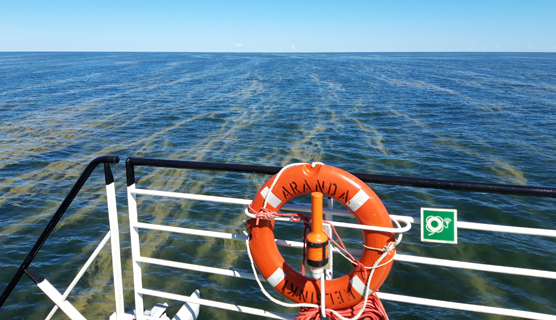Sea sees abundant cyanobacteria this summer
Published : 26 Aug 2022, 00:33
Cyanobacterial levels in sea areas and lakes peaked during the hottest periods of the summer in mid-July and mid-August, said the Finnish Environment Institute (SYKE) in a press release on Thursday.
However, regional variation has been high, and the most abundant observations made in the national cyanobacterial monitoring were centred in a few nutrient-rich lakes.
The cyanobacterial bloom risk analysis was realised and abundant cyanobacteria were observed, especially in the southwestern, southern and western sea areas. In late August there have still been quite abundant cyanobacteria at sea and in lakes.
During the summer, the cyanobacterial situation in lakes has varied with the weather. In the early summer, cool weather curbed the formation of cyanobacterial blooms, and the cyanobacterial situation was characteristic of the time of year.
After the warming of the weather after Midsummer, cyanobacterial blooms became more abundant in many places.
The cooler weather in late July lowered the surface temperature of lakes and weakened the cyanobacterial blooms.
As a result of winds, the cyanobacteria also remained mixed with the surface waters.
At the beginning of August, warm weather raised the temperature of surface waters by several degrees in the whole country. In addition to this, strong winds and rainfall brought nutrients from the lakebeds and the catchment area, and so cyanobacterial blooms became again more abundant almost throughout the country.
The cyanobacterial situation in lakes has been subject to great regional and local variation during the summer.
In the regions of Uusimaa, Southwest Finland and Kainuu, the summer’s cyanobacterial situation has been in line with the long-term average throughout the summer.
In the rest of the country, the cyanobacterial situation has fluctuated between both sides of the long-term average. The peak of cyanobacterial blooms was reached during the August heat wave, with the exception of Lapland.
This summer, the nationwide algal monitoring in lakes included about 275 sites. During the summer, cyanobacteria were observed at 138 sites, which is roughly the same number as in the previous summer. Some cyanobacteria were found at 100 sites, abundant occurrences at 68 sites and very abundant at only four sites.
cyanobacterial blooms occur in eutrophic lakes where phosphate phosphorus nutrients are abundant. In the most eutrophic lakes, cyanobacterial blooms have lasted for several weeks this summer.
“In other lakes, cyanobacterial blooms may have lasted only for two to three weeks or less,” said Senior Research Scientist Kristiina Vuorio of the Finnish Environment Institute.
Towards the end of August, cyanobacterial blooms have become more abundant in some places. Very abundant cyanobacterial blooms have not been observed during the past week. Abundant cyanobacteria were observed at 14 monitoring sites and some cyanobacteria at 38 sites.
At the end of the summer holiday period, the number of cyanobacterial observations received from citizens has clearly decreased. In the last seven days, only 50 observations have been received through the observation courier service and the vesi.fi map service, 26 of which have been observations that included cyanobacteria.
Abundant cyanobacteria were observed during the summer in the southwestern, southern and western sea areas
In Finnish sea areas, the amounts of cyanobacteria began to increase already at the turn of June and July as a result of the hot weather. The number of cyanobacterial observations peaked for a couple of weeks in mid-July and again around mid-August.
Between these periods, cyanobacterial observations decreased momentarily due to the cooling weather. The amounts of cyanobacteria are still unusually high in late August, and if the weather and nutrient conditions continue to be favourable, cyanobacteria may occur in many areas well into autumn.
When seen nationally, cyanobacteria were on average more prevalent at coastal and archipelago algal observation sites during the peaks of June–August than during the corresponding periods in 1998–2021.
However, comparisons with previous years are only indicative, as the number and location of observation sites have varied over the years.
Most of the coastal observations were made in the Archipelago Sea, the western Gulf of Finland and the Bothnian Sea, but cyanobacteria also occurred in other coastal areas. On the coasts and in archipelagos, the amounts of cyanobacteria vary rapidly and the cyanobacterial situation can be very different in places very close to each other.
In the open sea areas near Finland, cyanobacteria were observed especially in the northern part of the Baltic Proper, south of Åland and the Archipelago Sea, in the Gulf of Finland from Gogland to the Archipelago Sea and in the Bothnian Sea as far up as Kvarken.
There have been less cyanobacteria in the eastern parts of the Gulf of Finland than in the western parts, but at the end of August, abundant cyanobacteria have been observed in some inlets in the eastern Gulf of Finland.
“Based on observations from the marine research vessel Aranda and Utö atmospheric and marine observation station, there were three species of cyanobacteria in the occurrences. Nodularia spumigena, Aphanizomenon flosaquae and Dolichospermum spp. were found in varying quantities in all samples. However, Nodularia spumigena was more abundant in the Gulf of Finland and the Bothnian Sea than in recent years”, said Senior Research Scientist of SYKE Sirpa Lehtinen.
There are differences between different species in their ecological characteristics and, among other things, in their production of harmful compounds. Nodularia spumigena has so far always been found to be toxic. Other species of cyanobacteria may also produce various liver and nerve toxins and other compounds that are harmful to health and may cause allergic symptoms. Cyanobacterial blooms should therefore always be treated with caution as they may pose a health hazard to humans and domestic animals.
“In the future, we want to investigate in more detail the species composition of cyanobacterial occurrences with satellite observations. We already use observations from six different satellites in our daily monitoring, so it’s possible to do a combined analysis of cyanobacteria species data and satellite observations from measurement voyages,” said Senior Scientist of SYKE Jenni Attila.


